 It’s really crazy to think that it’s been over 16 years now since USB 1.0 was released. Even looking back to USB 2.0 in April of 2000 it’s been 12 years that we have been living with that 60 MB/s theoretical speed. I can’t even imagine how many hours, days, maybe even weeks; I have spent waiting for files to transfer in those 16 years. When USB 3.0 was introduced in 2008 I literally couldn’t wait for the day I would finally be able to fully take advantage of the speeds that USB 3.0 brought to the table. Today for the first time I can say that I am taking full advantage. I’m going invite you all in to see what I am using to do this.
It’s really crazy to think that it’s been over 16 years now since USB 1.0 was released. Even looking back to USB 2.0 in April of 2000 it’s been 12 years that we have been living with that 60 MB/s theoretical speed. I can’t even imagine how many hours, days, maybe even weeks; I have spent waiting for files to transfer in those 16 years. When USB 3.0 was introduced in 2008 I literally couldn’t wait for the day I would finally be able to fully take advantage of the speeds that USB 3.0 brought to the table. Today for the first time I can say that I am taking full advantage. I’m going invite you all in to see what I am using to do this.
Written by: Wes
Pictures by: Wes
Product Provided by: Kingston, Trendnet, IOSafe, and Asus
What I am using
You are only as strong as the weakest link in a chain and in the case of USB 3.0 you are only as fast as the slowest link. Because of that you have to make sure you are running USB 3.0 across the board. In my case the biggest problem I had was my current case doesn’t support USB 3.0 with its front panel connections. This means if I wanted to use my motherboards USB 3.0 connections I would have to climb back behind my desk each time. I did this a few times with time sensitive file transfers but as a whole this isn’t something I would do every day.
I decided I would have to go with a powered USB 3.0 hub to run on my desk to give myself easy access to the ports as needed. After looking around at the hubs available I went with Trendnet’s TU3-H4, I wanted a hub that was powered and had all of the ports facing forward in a package that would fit well on my desk without being in the way. With the hub hooked up I finally had access to my motherboards high speed ports, but what would I use on them?

My USB usage is broken down into three things. Charging, low speed devices (mouse, keyboard, and webcam), and file storage. Going with USB 3.0 would only really be helpful with charging and file transfers, and I really only needed to find USB 3.0 devices for file transfers. For me it’s important to have portable storage, a backup storage device, and of course I have my collection of SD cards from all of our camera equipment and video cameras.
Although SD card performance isn’t anywhere near SSD’s you can still see an improvement when switching to USB 3.0 when using high speed cards. Considering how many times in a day that I am pulling files off of an SD card it was very important to find a USB 3.0 card reader. Of course my last three readers didn’t hold up to my use, so it was also important that any reader I went with be of the highest quality. We ended up going with two devices from Kingston, one for office only use and a second for on the go. The models are the Kingston USB 3.0 Media Reader (FCR-HS3) and MobileLite G3 USB 3.0 Reader(FCR-MLG3), Kingston’s entire lineup of USB 3.0 card readers.
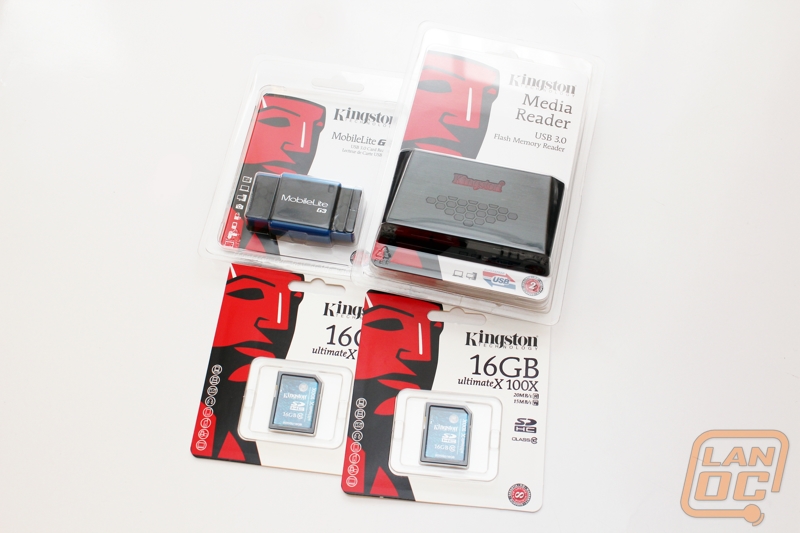
For our backup device we went with the IOSafe Rugged Portable that we recently covered. It fit my needs for capacity and speed and went well and above on actually protection of your data. Perfect for backing up files while on the go.
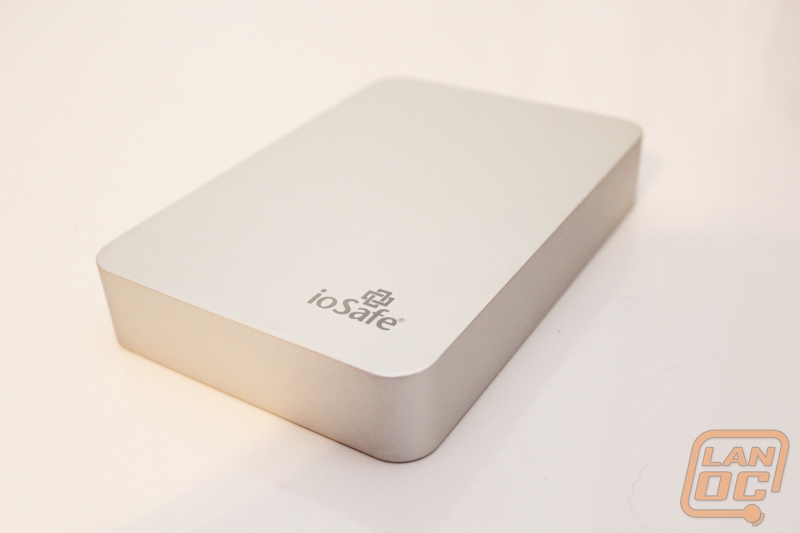
For a flash drive I wanted something portable but still very durable. Capacity was also important as there are a lot of times that I use a flash drive to setup our test benches with programs and all of their drivers. I went with Kingston once again with their 64Gb DataTraveler HyperX 3.0. Even in its smallest capacity it is large enough to get the job done and fits the bill for durability and speed as well.

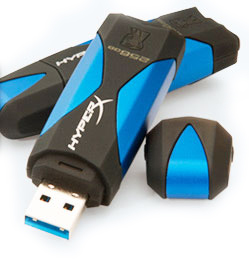
Of course we won’t know how all of these devices worked out until we put them to the test.
Specifications
Kingston USB 3.0 Media Reader
USB 3.0 — up to 5.0Gb/s data transfer speed
Ultra portable; sleek metal construction
Maximize the full speed potential of your memory cards
Built-in LED indicator and three-foot USB 3.0 cable
Portable — convenient small size
Versatile — works with the following Flash card formats:
CompactFlash, CF Type I (UDMA 0-6), CF Type II (UDMA 0-6), SD, SDHC, SDHC UHS-I, SDXC, SDXC UHS-I, microSD, microSDHC, microSDXC, Memory Stick/M2, Memory Stick, Memory Stick PRO, Memory Stick Duo, Memory Stick PRO Duo, Memory Stick M2
Requirements — system with USB 3.0 port
Backwards Compatible — with USB 2.0
Dimensions 3.66" x 2.07" x 0.63" (93.17mm x 52.68mm x 16.00mm)
Speed Rating* USB 3.0, up to 5.0Gb/s data transfer speed
Operating Temperature 32º to 140ºF / 0º to 60ºC
Storage Temperature -4º to 185ºF / -20º to 85ºC
Operating System Compatibility Windows 7, Windows Vista (SP1, SP2), Windows XP (SP3)
Guaranteed two-year warranty
Kingston MobileLite G3 USB 3.0 Reader
Compliant — with the USB 3.0 specification, SDA 3.01 standard
Versatile — multi-functional USB card reader supports SD/SDHC/SDXC, microSD/SDHC/SDXC and MSPD
Backwards compatible with USB 2.0
Portable — easily fits in your pocket
Guaranteed — two-year warranty, free technical support
Dimensions 2.45" x 1.16" x 0.646" (62.15mm x 29.40mm x 16.40mm)
Operating Temperature 32°F to 140°F (0°C to 60°C)
Storage Temperature -4° to 158° F (-20°to 70°C)
DataTraveler HyperX 3.0
|
Capacities |
64GB, 128GB, 256GB |
|
Dimensions |
2.952" x 0.916" x 0.626" (74.99mm x 23.29mm x 15.9mm) |
|
Operating Temperature |
32°F to 140°F (0°C to 60°C) |
|
Storage Temperature |
-4°F to 185°F (-20°C to 85°C) |
|
Practical |
durable casing with a solid lanyard loop Speed: |
|
Speed |
USB 3.0: 225MB/s read and 135MB/s write USB 2.0: 30 MB/s read and 30MB/s write |
|
Backwards Compatible |
with USB 2.0 |
|
ReadyBoost™ Support |
Yes |
|
Guaranteed |
five-year warranty, free technical support |
IOSafe Rugged Portable
|
Data Recovery Service (DRS) and No-Hassle™ Warranty |
|
• 1 Year Data Recovery Service (DRS) included – one time, any reason, no questions asked • 1 Year No-Hassle™ Warranty included – replacement or repair for any defects or damage • DRS includes accidental deletion, any damage, disasters or hardware failure • Up to $2500 included for third party forensic recovery service if needed for DRS (HDD versions) • Up to $5000 included for third party forensic recovery service if needed for DRS (SSD versions) • 3 and 5 year upgrades for DRS and No-Hassle™ Warranty plans available at www.iosafe.com |
|
Construction and Physical Security Speci?cations |
|
• Full Metal Jacket™ Technology – CNC machined enclosure from a solid billet of aluminum (Al) or titanium (Ti) alloy. Crush resistant to up to 5000 lbs (Ti) and 2500 lbs (Al) yet weighs as little as a pound (Al). • Full Suspension Drive™ Technology – Full suspension in all six axes of motion. Optimized for data loss protection from drop and shock of 20’ drops (SSD version) and 10’ drops (500 GB HDD version, 1TB HDD requires optional drive skin) per MIL-STD-810G Method 516.5. • HydroSafe™ Technology – Waterproof yet heat conducting barrier to protect against data loss up to 10’ for 3 days in fresh water or salt water (aluminum version) or 30’ for 3 days (titanium version) per IP68. Protects data even when USB plug is in. No requirement for a connector cap to retain data protection. • ChemSafe™ Technology – Full immersion in diesel fuel, oils, hydraulic ?uids, aircraft fuels, 12” depth for 1 hour with no data loss per MIL-STD-810G Method 504 • EnviroSafe™ Technology – Continuous exposure to UV, blowing sand, blowing dust, rain, salt fog, icing or freezing rain, 24 hours with no data loss per MIL-STD-810G Methods 505.4, 506.4, 509.4 and 510. • AltiSafe™ Technology – High altitude operation. 15K ft. (Alum.) and 30K ft. (SSD and Ti.) rated altitudes per MIL-STD-810G Method 500.4 • Theft Resistant Kensington® Lock compatible slot solid metal construction – theft protection |
|
Software Speci?cations (included but not required for use) |
|
• Genie Timeline™ Pro Full Version ($60 Value) Award winning backup software. Simple, block level, open ?le and OS Continuous Data Protection (CDP) software for Windows users. Disaster recovery for entire hard drive including programs and settings, roll back and AES encryption features for the ultimate protection. Registration required at www.iosafe.com to validate purchase prior to downloading software and install code. • Apple® Mac® TimeMachine® Supported – Apple Time Machine fully supported. Reformat of device may be required. Simple instructions online at www.iosafe.com • TrueCrypt® AES-256 Encryption Compatible - Open source, encryption software. FIPS 140-2, ISO/IEC 10118-3:2004. PC, Mac and Linux compatible. |
|
Operational Details |
|
5400 HDDs available, 500GB – 1TB capacities • SSD capacities from 120GB-600GB • Billet-machined Aluminum (1lb.) and Titanium (1.5 lb.) enclosures (3.9"W x 5.7"L x 1.0"H) • Multi-platform compatibility with Mac & PC/Windows • USB 3.0 (compatible with USB 2.0 computers) |
|
Inside The Box |
|
• ioSafe Rugged Portable + DRS • USB 3.0 Cable (USB 3.0 version), • USB Micro-B Y-Cable (for low powered USB 2.0 ports) • Owners Manual and Warranty |
|
System Requirements |
|
• Intel Pentium II 350 Mhz-compatible or Mac G3 processor & greater • For USB 3.0/USB 2.0 speeds, the system must support applicable speci?cations |
|
Operating Environment |
|
• Operating: 0 to 35°C (32 to 95°F) for HDD versions • Operating: 0 to 40°C (32 to 104°F) for SSD versions • Non-operating: -40°C to 65°C (-40 to 149°F) all versions • Operating Humidity: 5% - 80% (non-condensing) all versions • Non-operating Humidity: 100%, Full immersion, 10 feet, 3 days (Aluminum version) • Non-operating Humidity: 100%, Full immersion, 30 feet, 3 days (Titanium version) |
Performance
I can and will show you the performance numbers that we experienced testing out all of these USB 3.0 devices, but it’s also important to look beyond the numbers at how much time and frustration that moving to a faster interface can save you. Imagine how frustrating it would be if every road had a speed limit of 20 MPH when your car is capable of much more.
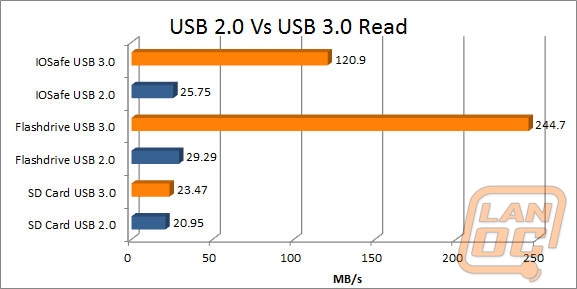
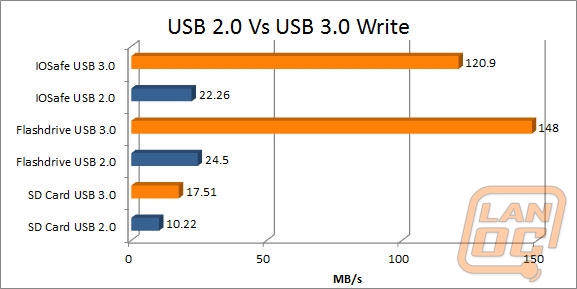
As you can see on both the read and write speed benchmarks using Crystal Disk Mark, the difference between the USB 3.0 and USB 2.0 is worlds apart. When using both the IOSafe hard drive and the Kingston flashdrive you are missing out on a lot when going to USB 2.0. The SD card on the other hand didn’t show much of an improvement.
Having used all three for weeks I wasn’t surprised by the results of the flashdrive and IOSafe, but the SD card was surprising. When using the USB 3.0 card reader day to day I noticed a major difference in performance in both card access times as well as how quickly I could move files on and off the card. This is one of those situations where the performance numbers really don’t show the real world improvement.
What does the increase in performance mean as a whole? Increased transfer times mean less time waiting on file transfers. This is only going to become more and more important as file sizes continue to grow. A good example of this is the flash drive that we went with. Only just a few years ago our first 64 gig flash drive was the largest capacity that you could find, now the 64 gig flash drive is the smallest that Kingston offers in this model.
Although all of my testing was done on an asus board, one thing I didn’t touch this time around was the use of Asus USB 3.0 Turbo boost. In our Asus Z77 board roundup I tested this a little more in depth and was blown away by the performance numbers we were able to see. Expect to see more manufactures taking advantage of stuff like this in the future. We can and will see amazing speeds with USB 3.0 for some time to come.
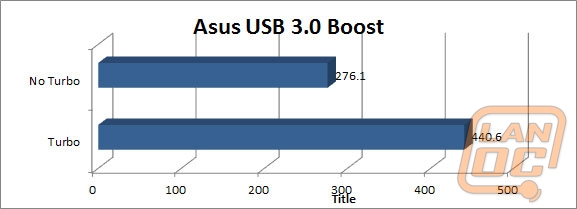
Overall
Jumping to USB 3.0 isn’t something you want to do all at once typically, even though the performance increases are well worth it. The cost of USB 3.0 devices is still at a premium, but picking them up as you need to replace different components is highly recommended, as I did. Like I mentioned before, in the end your performance is only as good as your weakest link, but you might as well be prepared. USB 3.0 isn’t going anywhere, if you aren’t considering them now you will be kicking yourself soon enough when your new USB 2.0 flash drive has you waiting an hour to transfer files to and from it. I for one welcome our new USB 3.0 overlords! Of course with thunderbolt starting to make its way into PC’s, how long before we start looking to it for even better transfer speeds.




